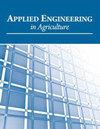寒区植物/作物生产温室能源可持续设计与运行研究进展
IF 0.8
4区 农林科学
Q4 AGRICULTURAL ENGINEERING
引用次数: 0
摘要
在寒冷地区,温室空间供暖的巨大能耗是一个重大问题。提出了常规和非常规设计方面的节能措施。可再生资源在温室中具有相当大的应用潜力。寒冷地区温室的能源消耗,特别是空间供暖,是巨大的,因此在经济上是不可承受的。本文的主要目的是为寒冷地区温室的设计和运行提供最先进的节能策略的全面审查。本文综述了温室的常规功能(照明、空气质量和温度控制、灌溉)、非常规功能(隔热、热能储存、地源和可再生能源的利用)以及温室能源性能的数值模拟。对于这些主题中的每一个,都提供了相关的植物科学和性能评估。本综述的研究结果表明,混合照明(LED与高压钠灯)和适当的调度可以实现能源效率和植物产量的最佳结合。然而,这一领域还需要进一步的研究。关键词:寒区;能效;温室;本文章由计算机程序翻译,如有差异,请以英文原文为准。
A Review on Energy-Sustainable Design and Operation of Greenhouses for Plant/Crop Production in Cold Regions
HighlightsIn cold regions, the immense energy consumption for space heating of greenhouses is a significant problem.Energy-efficient measures have been presented for conventional and nonconventional design aspects.Renewable resources have considerable potential to be used in greenhouses.Abstract. The energy consumption of greenhouses in cold regions, especially for space heating, is immense and therefore economically unbearable. The main objective of this article is to provide a comprehensive review of state-of-the-art energy-saving strategies for the design and operation of greenhouses in cold regions. The review covers conventional functions (lighting, air quality and temperature control, and irrigation), nonconventional functions (thermal insulation, thermal energy storage, and utilization of ground-source and renewable energy), and numerical modelling of the energy-performance of greenhouses. For each of these topics, pertinent plant science is provided and performance assessments are presented. The findings from this review conclude that hybrid lighting (LED with high-pressure sodium lamps) and proper scheduling result in the best combination of energy efficiency and plant yield. However, further studies are still required in this field. Keywords: Cold regions, Energy-efficiency, Greenhouse, Sustainability.
求助全文
通过发布文献求助,成功后即可免费获取论文全文。
去求助
来源期刊

Applied Engineering in Agriculture
农林科学-农业工程
CiteScore
1.80
自引率
11.10%
发文量
69
审稿时长
6 months
期刊介绍:
This peer-reviewed journal publishes applications of engineering and technology research that address agricultural, food, and biological systems problems. Submissions must include results of practical experiences, tests, or trials presented in a manner and style that will allow easy adaptation by others; results of reviews or studies of installations or applications with substantially new or significant information not readily available in other refereed publications; or a description of successful methods of techniques of education, outreach, or technology transfer.
 求助内容:
求助内容: 应助结果提醒方式:
应助结果提醒方式:


